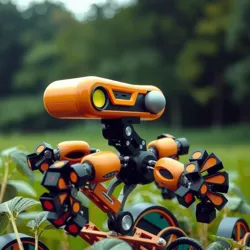Bio-Inspired Robotics

Bio-Inspired Robotics is a field of study and innovation where engineering principles are derived from the characteristics and performance of biological organisms. This approach to robot design seeks to leverage the adaptive, efficient, and resilient traits found in nature to address complex engineering challenges.
Overview
Bio-inspired robotics involves creating machines that mimic the form, function, and behavior of living organisms. This scientific discipline integrates knowledge from biology, engineering, computer science, and materials science to develop robots that can perform tasks in ways that traditional designs cannot. The ultimate goal is to create robots that are more efficient, adaptable, and capable in their environments.
Applications
Bio-inspired robotics has a wide range of applications, including:
-
Environmental Monitoring: Robots such as the Robo-Nautilus and Aqua Squid are designed to explore and monitor marine environments, inspired by the movement and sensory capabilities of aquatic creatures.
-
Medical Devices: Robotic devices that mimic biological systems, such as advanced prosthetics and surgical robots, offer enhanced functionality and precision by replicating human or animal anatomy.
-
Search and Rescue: Robots that emulate the capabilities of animals, like dogs or insects, are used in disaster scenarios to navigate challenging terrains and locate survivors.
-
Agriculture: Bio-inspired robots are deployed to monitor crops and soil conditions, using mechanisms inspired by insects and birds to navigate and interact with agricultural environments.
Key Concepts
Several biological principles are central to bio-inspired robotics:
-
Biomimicry: The design philosophy of mimicking biological forms and processes to solve human problems, as exemplified by the Cybernetic Symbiosis framework that explores integrating biological and mechanical systems.
-
Adaptation: Robots are designed to adapt to changing environments and tasks, similar to the way organisms evolve to survive and thrive in their habitats.
-
Efficiency: By studying the energy-efficient movements of animals, engineers design robots that use minimal energy to perform complex tasks, much like the efficient propulsion of the Robo-Nautilus.
Challenges
While bio-inspired robotics holds significant promise, it also faces several challenges:
-
Complexity of Biological Systems: Replicating the intricate systems found in nature is a formidable engineering challenge, requiring sophisticated modeling and materials.
-
Integration of Mechanical and Biological Components: Achieving seamless integration between mechanical and biological elements is crucial for the success of bio-inspired designs, an area explored in projects like the Biomechanical Hive.
-
Ethical Considerations: As robots increasingly resemble and interact with living organisms, ethical issues regarding their use and impact on ecosystems must be carefully considered.
Future Prospects
The future of bio-inspired robotics is bright and full of potential. As technology advances, robots will likely become even more sophisticated, with improved autonomy and sensory capabilities. The integration of digital slang and advanced communication systems could enhance interactions not only between robots but also between humans and machines, leading to new possibilities in fields such as healthcare, exploration, and beyond.
See Also
Bio-inspired robotics continues to push the boundaries of what machines can achieve, drawing inspiration from the natural world to create innovative solutions that enhance our ability to understand and interact with the environment.